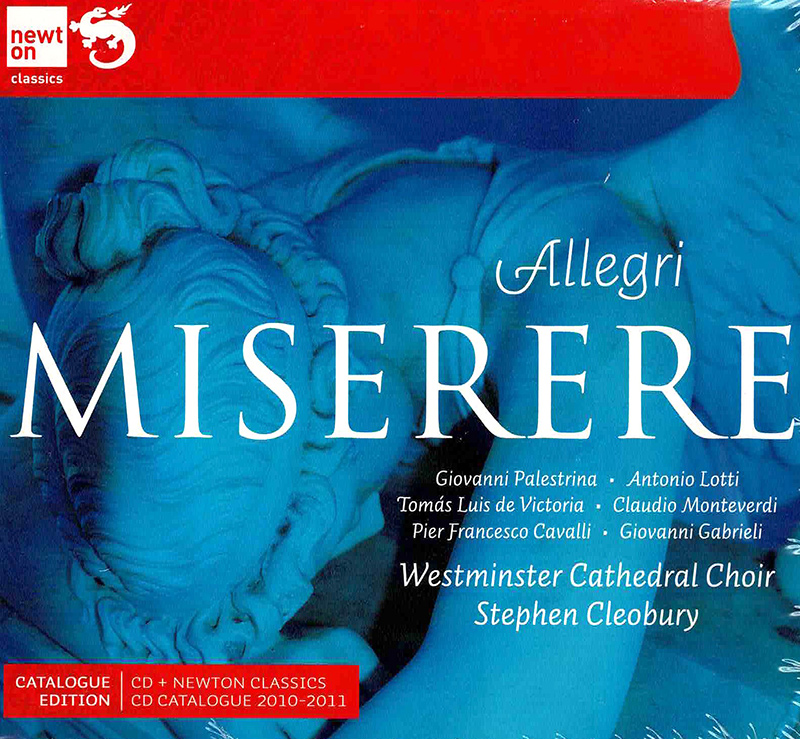Logowanie
Mikołaj - ten to ma gest!
Miles Davis, Horace Silver, Jay Jay Johnson, Percy Heath, Kenny Clarke, Lucky Thompson
Walkin'
20bit K2Super Coding - ale jak to brzmi!
Kasety magnetofonowe
Winylowy niezbędnik
ClearAudio
Double Matrix Professional - Sonic
najbardziej inteligentna i skuteczna pralka do płyt winylowych wszelkiego typu - całkowicie automatyczna
ALLEGRI, PALESTRINA, VICTORIA, MONTEVERDI, CAVALLI, Westminster Cathedral Choir, Stephen Cleobury
Miserere
- Westminster Cathedral Choir - choir
- Stephen Cleobury - conductor
- ALLEGRI
- PALESTRINA
- VICTORIA
- MONTEVERDI
- CAVALLI
I must confess that this is the first time I have encountered Newton Classics. This is not that surprising because in the catalogue that accompanies this disc their founder Theo Lap has written that “our initial releases were in June 2010”; I am writing this in mid-May 2011. Their repertoire includes a range from Gregorian Chant to Berio via the Renaissance. We are also informed that the recordings “are sourced from the vaults of major record labels”. Their featured artists include the likes of Sir David Willcocks, Sir Neville Mariner and Karl Münchinger. This ex-Decca CD dates from the early 1980s and the music comprises - just as it says on the box - classics of the high renaissance. The selected pieces are generally standard works. They are highly regarded as well as being representative of the period with the greatest Italian composers appearing. I suppose the biggest surprise might be the happy inclusion of Cavalli’s Salve Regina for men’s voices which is, for me, one of the highlights - both the setting itself and its sensitive execution. The CD’s cover emblazons the title Miserere taken from Allegri’s famous piece but this is not a performance to which I will return with any alacrity. The boys’ tone sounds pinched, the tuning is not consistent and the soloists do not all find the top C to their liking. Let’s face it, it’s the trebles that capture the piece for most listeners so I’m sorry to have started with a negative. That said, I can move on a little more positively. It may surprise some of you that not all of the music is unaccompanied. Cavalli’s setting has an organ part, and you would expect Gabrieli’s Jubilate Deo to have instrumental participation. Monteverdi’s exciting Cantate Domino, for example, with its various changes from duple to triple time does not, but the organ helps to bolster the sound and adds to the work’s general nobility. The same instrument affords useful support in the long sustained lines of the Adoramus te. The booklet essay by Andrew Stewart acts as a useful introduction, without being technical, to the history of Renaissance music leading into the early baroque. There’s an explanation of how things developed in St. Mark’s Venice and of Palestrina’s so-called rescuing of polyphony in Rome under Pope Marcellus. The choir have this sort of music in their blood and even if it is performed a little brashly here Tu es Petrus is surely one of Palestrina’s most radiant motets. Lotti’s extraordinary and seemingly isolated Crucifixus is not strictly Renaissance but its counterpoint, although creating many painful and beautiful dissonances, is wrought around the line-logic of an earlier period. It comes off very well under Cleobury. What I mean by brashness as mentioned above is, sometimes, an over-brightness emerges in the boys’ tone which Cleobury may well have been cultivating at that time. However it grates as far as my ear is concerned. Westminster Cathedral has always had a reputation for an Italianate approach to Latin vowels and to this repertoire. They have developed a vocal colour to suit but whether this pushing up at notes, creating this glaring and even strained tone in the boys was brought about by a long day over a hot microphone or if it has something to do with the recording or acoustic I do not know. The former seems to be more likely as not all of the pieces ‘suffer’ in this way. In quieter motets like Palestrina’s emotional but often passionate Peccantem me quotidie the problem is far less acute although I do find consistently that there is a forcing of the tone in too many places. Victoria’s Lauda Sion finds the composer in unusually unbuttoned mood. It is for double choir a capella. Here the Westminster choir are superb in precision and tone and also in conveying just the right attack and the contrasting moods. If you are coming reasonably new to the music of the high renaissance then this disc is a really good place to start, despite its short playing time which might put you off. It contains so many standard classics. If you know these works then I can only suggest that you take the advice of the Irishman - who in fact almost never says it - that it’s probably best if you don’t start from here. Texts with good translations are provided. Gary Higginson






























